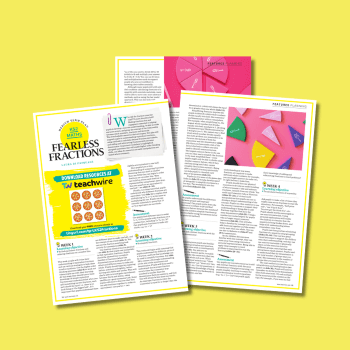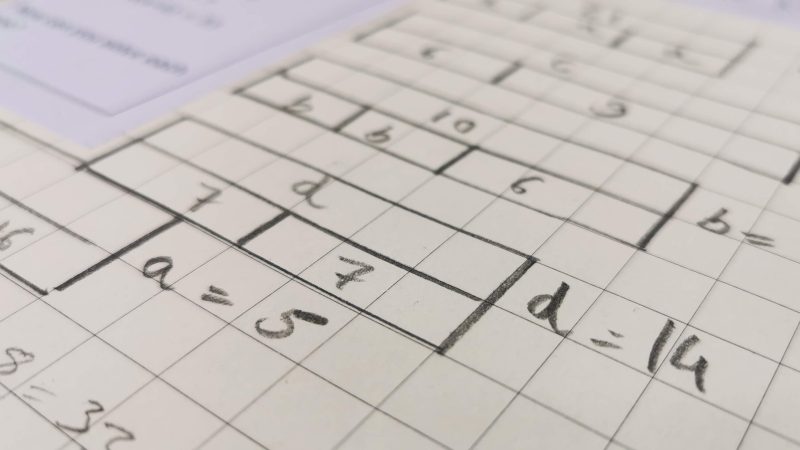Power of positivity – Teaching maths in primary school

While learning can lead to feeling good, is there any evidence that feeling good enables learning? Mike Askew shows there is, and shares practical suggestions for maths lessons…

- by Mike Askew

How do we decide what a ‘good’ mathematics lesson might look like?
One model I like suggests that quality mathematical teaching requires a blend and balance of:
- Cognitive activation
- A supportive climate
- Classroom management
Cognitive activation is just a fancy way of saying pupils need to think in lessons, and no one would question that sound classroom management is needed for learning to go well.
A supportive climate is, I believe, sometimes thought of as more or less taking care of itself – get pupils thinking about some interesting mathematics in a well-managed class and the climate naturally will be supportive.
But is it only the case that a supportive, positive, classroom climate emerges as a result of pupils sensing they are making gains in learning mathematics, or can taking deliberate action to build a positive climate actually lead to better learning?
The recently published Ofsted review into teaching and learning mathematics comes down firmly on the learning-leads-to-feeling-positive side of this argument, claiming that pupils develop positive attitudes towards mathematics when they succeed at it – a sentiment with which I expect we could all agree.
I would also go along with the review’s recommendation that trivializing mathematics, just so that everyone feels good, is not the way to go.
But I part company with the review’s advice on avoiding thinking that positive emotions can lead to better learning, as there is research evidence showing that this direction of causality – feeling-positive-supports-learning – is equally important.
Promoting positive emotions
One theory that has shown the power of positive emotions is psychologist Reinhard Pekrun’s Control-Value theory that pupils’ emotional responses to lessons are influenced by two things:
- What sense of control they have over what they are asked to do
- How much they value what they are doing, either as important in its own right (intrinsic value) and/or in terms of achievement, of ‘doing well’ (extrinsic value).
Values are general, and long lasting (‘I really like maths’ or ‘I want to do well’) and so take time to develop or change. Sense of control, on the other hand is short-term, linked to specific experiences, and so more easily influenced by the way mathematics lessons are set up and enacted.
Another thing shown to promote pupils having a sense of control is giving them with opportunities to make choices. But how might pupils be offered choices without mathematics lessons turning into ‘anything goes’ situations?
The Canadian author Marian Small suggests in her book – Good questions: Great ways to differentiate mathematics instruction (2008) –two ways to provide some choice without diminishing the quality of the mathematics:
Choice of two tasks
Rather than pre-determining that different pupils may need to be given different tasks to meet different needs, Small advocates letting the pupils themselves determine which of two tasks to do.
Take, for example, this problem (adapted from one of Small’s problems):
Will Mike and Jo ever have the same number of grapes?
Choice 1:
- Mike has 30 grapes and Jo has 12.
- Mike gives Jo 3 grapes at a time.
Choice 2:
- Mike has 50 grapes and Jo has 10.
- Mike gives Jo 5 grapes at a time.
While each option involves counting down and up, pupils may choose initially to work on choice one as the numbers are smaller. But they may come to reason that although the numbers are larger in choice two, the calculations are actually simpler.
Another example (again adapted from Small’s work) is to ask pupils to mark two dots on a piece of paper. They can choose between:
- Choice 1: Making a square with the dots as corners
- Choice 2: Making a parallelogram with the dots as corners
- Choice 3: Making an isosceles triangle with the dots as corners
Choice three might at first appear to the easiest option, as only one other point is needed, but it is actually challenging. And all three choices allow for more than one solution.
As these examples show, not only might offering pupils a choice of problems help them to develop a sense of control, it can also get them thinking more deeply about the mathematics.
Choice of values to work with
The second strategy that Small suggests is to set up tasks in ways that require pupils to make a choice of numbers with which to work.
For instance, in a problem like the one below, having more than one blank to fill opens up the range of choice.
_____ is 8 less than _____ Find five pairs of numbers that make this statement true.
In thinking about what pairs of values would work, pupils are encouraged to think about the patterns in the answers and the underlying mathematical structure. Not only do they get to do some subtractions, they deepen their understanding of ‘less than’.
Other examples could be things like:
- ___ is double ___
- ___ is 25% of ___
- ___ is 8 more than ___
- 8 is ___ (fraction) of ___
- ___ is five times ___
- ___ is 3/5 of ___
- 7 is ___ minus ___
- 7 is ___ % of ___
Finally, problem solving is also a way to give pupils the opportunity to make choices, particularly if the problem offered allows them to choose a solution method and how they might represent their solution.
The power of positive
Up until around 15 years ago, research into the impact of emotions on learning mathematics focused mainly on the impact of negative emotions, for example, fear or anxiety, with the assumption that positive emotions, whilst desirable, had less impact on learning than negative emotions.
Evidence now shows, however, that actively fostering positive attitudes is valuable in its own right and contributes to learning in ways that are different from simply removing negative emotions.
The psychologist Barbara Fredrickson has developed a ‘broaden-and-build’ theory, which, backed up by empirical evidence, posits that positive emotions go beyond feeling good about experiences, but they promote a ‘building’ response to experiences.
That is, positive emotions increase attention and awareness and as a consequence we respond more broadly to experiences.
Evidence from work based on Fredriksson’s broaden-and-build theory applied to classrooms indicates that positive emotions go beyond indicating that learning is going well; that establishing positive emotions creates the conditions for learning to go well.
And there is evidence to show that this does impact on learning. Positive emotions such as enjoyment correlate with positive gains in mathematics grades and test scores across years of schooling, and conversely, negative emotions such as boredom and anxiety have negative effects on attainment.
Importantly, this productive impact of positive emotions extends beyond the current moment. A virtuous cycle is set up – presenting mathematics in ways that promote positive emotions results in pupils engaging more creatively with the mathematics which in turn fosters more positive responses towards the mathematics.
In short, positive emotions are not a merely nice ‘add-on’ to mathematics teaching, they actively foster and support learning.
Mike Askew is adjunct professor of education at Monash University, Melbourne. A former primary teacher, he now researches, speaks and writes on teaching and learning mathematics. Follow him on Twitter at @mikeaskew26











